Difference between revisions of "Ki-43 (Family)"
battalionier (talk | contribs) m |
m (→Development History) |
||
| (7 intermediate revisions by 3 users not shown) | |||
| Line 1: | Line 1: | ||
| − | |||
| − | |||
==Description== | ==Description== | ||
| − | The '''Nakajima Ki-43''' officially designated '''Army Type 1 Fighter''' | + | The '''Nakajima Ki-43''', officially designated '''Army Type 1 Fighter''', was the most numerous of all single-seat fighters used by the Imperial Japanese Army in World War II. While operating in Malaysia and Burma, the plane received the codename "Jim", and in the Pacific Theatre, it received the allied codename "Oscar". The codename "Oscar" was eventually selected as the official codename for the airplane by the Allies. |
| − | Nicknames | + | Nicknames: |
* ▅ - ''Hayabusa'' (隼, Peregrine Falcon) | * ▅ - ''Hayabusa'' (隼, Peregrine Falcon) | ||
| − | * | + | * ▄ - ''Jim'' |
* ▃ - ''Oscar'' | * ▃ - ''Oscar'' | ||
| + | ==Development History== | ||
| + | |||
| + | In early 1937 the Army recognized that its current fighter, the Type 97 Fighter ([[Ki-27 (Family)|Ki-27]]), would not be able to compete against new designs that were starting to enter production worldwide, such as the Bf 109 in Nazi Germany. It was also recognized that the Ki-27 had to perform an extremely varied set of missions, from air supremacy against other fighters to bomber interception, and that a single new aircraft type might not be able to accomplish all of the Army’s required missions in the future. With this in mind, the Army requested two new fighter aircraft types to meet its future needs. The first would be a direct successor to the Ki-27: a low-altitude fighter focused on defeating enemy planes. In contrast, the second would be a more heavily-armed high altitude plane focusing on destroying enemy bombers. | ||
| − | + | Instead of requesting manufacturers to submit designs, the Army directly contracted Nakajima to produce replacements for their Type 97 Fighters. This was due to political and economic pressures from the aircraft design companies, as the cost of failed bids was something that could bankrupt a company. With the lack of a bidding process, the Army laid rigid requirements for this new low-altitude dog-fighter to Nakajima. The new aircraft type was to have a top speed of 311 mph, to be able to reach 16,405 ft within five minutes, to have a minimum range of 500 miles, and it was to be armed with two 7.7 mm machine guns and not lose any of the manoeuvrability of the Ki-27. These requirements proved to be unachievable using the currently available technology. The plane ended up being an airplane designed by compromise instead of the purpose-designed dogfighter the Army wanted. | |
| − | + | The first prototype of what was to become the Ki-43 was completed in December 1938, with two more following soon after in 1939. Upon testing by army pilots, the compromise nature of the plane became instantly apparent, and it was found that these airplanes did not live up to the Army’s expectations for a successor to the highly successful Ki-27. Test pilots complained that the plane was not manoeuvrable enough, hard to control, and had visibility issues. To make matters worse, the plane performed worse in almost every aspect, then an improved version of the Ki-27 was also being developed by Nakajima. The Army decided that the aircraft was not something they were interested in and stopped support of its development. The one positive to come out of testing the initial three prototypes was the Nakajima Ha-25 engine, which the Army saw as an excellent engine and was immediately ordered into production. The Ha-25 would even go on to create the Sakae series of engines that would be used in the Navy’s new fighter, the [[A6M]]. | |
| − | + | After evaluating the initial three prototypes, Nakajima would continue developing the aircraft independently. Without the stringent requirements of the Army guiding the development, a more focused design process could begin. Nakajima would construct 10 test aircraft with various modifications to address the Army’s concerns with the initial three prototypes. The changes tested included giving the fighter the more powerful HA-105 engine, replacing the 7.7 mm machine guns with 12.7 mm machine guns, upgrading the outer skin to treated duralumin, a narrower fuselage, redesigned tail surfaces, modifications to the wing design, and the introduction of “butterfly” flaps. These flaps could be deployed to increase the controllable wing surface, allowing the plane to overcome the lack of manoeuvrability that the Army had issues with and transforming the aircraft into a successful fighter design. | |
==Vehicles== | ==Vehicles== | ||
| − | {| | + | {{Family-card |
| − | |- | + | |title = Ki-43-I |
| − | | | + | |img = File:ArtImage_Ki-43-I.jpg |
| − | [[ | + | |wiki = Ki-43-I |
| − | == | + | |text = After the 10 improved prototypes were tested, the Army settled on what they saw was the optimum configuration and requested that the production aircraft be equipped with the Nakajima Ha-25 engine. |
| + | |||
| + | The final design entered production as the Ki-43-Ia (Army Type 1 Fighter Model 1 Ko), with the first example completing production in April 1941. | ||
| + | |||
| + | This model was soon replaced with the Ki-43-Ib (Army Type 1 Fighter Model 1 Otsu), which replaced one of the 7.7 mm machine guns with a 12.7 mm machine gun, which was also soon replaced by the Ki-43-Ic (Army Type 1 Fighter Model 1 Hei) which was equipped with two 12.7 mm machine gun. | ||
| + | |||
| + | [[Ki-43-I#History|'''Click here to read more''']] | ||
| + | }} | ||
| + | |||
| + | {{Family-card | ||
| + | |title = Ki-43-II | ||
| + | |img = File:ArtImage_Ki-43-II.jpg | ||
| + | |wiki = Ki-43-II | ||
| + | |text = After some time in the field, the Ki-43 received a major upgrade based on feedback from pilots, which included replacing the Ha-25 engine with the more powerful Ha-115 engine, a two-stage supercharger, pilot armour, self-sealing fuel tanks and many more minor improvements. The first prototype of what was to become the Ki-43-II (Army Type 1 Fighter Model 2) was completed in February 1942. | ||
| + | |||
| + | [[Ki-43-II#History|'''Click here to read more''']] | ||
| + | }} | ||
| + | |||
| + | {{Family-card | ||
| + | |title = Ki-43-II (USA) | ||
| + | |img = File:KI-43-II_USA.jpg | ||
| + | |wiki = Ki-43-II (USA) | ||
| + | |text = In late 1942, the Australian Army managed to capture an intact example of a Ki-43 while fighting the Japanese Army in Papua New Guinea. It was quickly shipped back to Australia for testing, where it ended up in the hands of the Technical Air Intelligence Unit, who managed to repair it using parts from downed airplanes. It was painted in US livery and was used to test its performance against Allied planes. After testing by the Technical Air Intelligence Unit, it was shipped to the United States for further evaluations. | ||
| + | |||
| + | [[Ki-43-II_(USA)#History|'''Click here to read more''']] | ||
| + | }} | ||
| − | + | {{Family-card | |
| − | + | |title = Ki-43-III ko (China) | |
| − | | | + | |img = File:Ki-43-III China.jpg |
| − | + | |wiki = Ki-43-III ko (China) | |
| − | + | |text = After the end of the war, some nations used the Ki-43, including the Indonesian People's Security Force who used them against the Dutch, and the French, who used them against Communist forces in Indochina. One such post-war user was the Nationalist Chinese Air Forces who operated captured Ki-43's in the 6th group. These saw use against the Communist Chinese forces in the Chinese Civil War, and 5 were eventually captured and used by the Chinese Communist Air Force until 1952. | |
| − | |||
| − | + | [[Ki-43-III ko (China)#History|'''Click here to read more''']] | |
| − | + | }} | |
| − | | | ||
| − | |||
| − | |||
| − | |||
| − | |||
| − | |||
| − | |||
| − | |||
| − | |||
| − | |||
| − | The last major modification of the Ki-43 was done in 1944, combining the minor modifications of the IIa and IIb with the more powerful Nakajima Ha-115-II engine. These minor modifications over the Ki-43-II included a reduced wing-span (improving the plane's low and medium speed performance), increased pilot armour, improved oil cooler, and modified | + | {{Family-card |
| − | + | |title = Ki-43-III otsu | |
| − | + | |img = File:ArtImage_Ki-43-III otsu.jpg | |
| − | + | |wiki = Ki-43-III otsu | |
| − | + | |text = The last major modification of the Ki-43 was done in 1944, combining the minor modifications of the Model IIa and IIb with the more powerful Nakajima Ha-115-II engine. These minor modifications over the Ki-43-II included a reduced wing-span (improving the plane's low and medium speed performance), increased pilot armour, improved oil cooler, and modified carburettor intake. This new Ki-43-IIIa (Army Type 1 Fighter Model 3 Ko) entered production in October 1944, with approximately 1,000 completed before the war ended. | |
| − | |||
| − | + | [[Ki-43-III otsu#History|'''Click here to read more''']] | |
| − | + | }} | |
| − | |||
{{AirManufacturer Nakajima}} | {{AirManufacturer Nakajima}} | ||
Latest revision as of 00:38, 20 October 2022
Description
The Nakajima Ki-43, officially designated Army Type 1 Fighter, was the most numerous of all single-seat fighters used by the Imperial Japanese Army in World War II. While operating in Malaysia and Burma, the plane received the codename "Jim", and in the Pacific Theatre, it received the allied codename "Oscar". The codename "Oscar" was eventually selected as the official codename for the airplane by the Allies.
Nicknames:
- ▅ - Hayabusa (隼, Peregrine Falcon)
- ▄ - Jim
- ▃ - Oscar
Development History
In early 1937 the Army recognized that its current fighter, the Type 97 Fighter (Ki-27), would not be able to compete against new designs that were starting to enter production worldwide, such as the Bf 109 in Nazi Germany. It was also recognized that the Ki-27 had to perform an extremely varied set of missions, from air supremacy against other fighters to bomber interception, and that a single new aircraft type might not be able to accomplish all of the Army’s required missions in the future. With this in mind, the Army requested two new fighter aircraft types to meet its future needs. The first would be a direct successor to the Ki-27: a low-altitude fighter focused on defeating enemy planes. In contrast, the second would be a more heavily-armed high altitude plane focusing on destroying enemy bombers.
Instead of requesting manufacturers to submit designs, the Army directly contracted Nakajima to produce replacements for their Type 97 Fighters. This was due to political and economic pressures from the aircraft design companies, as the cost of failed bids was something that could bankrupt a company. With the lack of a bidding process, the Army laid rigid requirements for this new low-altitude dog-fighter to Nakajima. The new aircraft type was to have a top speed of 311 mph, to be able to reach 16,405 ft within five minutes, to have a minimum range of 500 miles, and it was to be armed with two 7.7 mm machine guns and not lose any of the manoeuvrability of the Ki-27. These requirements proved to be unachievable using the currently available technology. The plane ended up being an airplane designed by compromise instead of the purpose-designed dogfighter the Army wanted.
The first prototype of what was to become the Ki-43 was completed in December 1938, with two more following soon after in 1939. Upon testing by army pilots, the compromise nature of the plane became instantly apparent, and it was found that these airplanes did not live up to the Army’s expectations for a successor to the highly successful Ki-27. Test pilots complained that the plane was not manoeuvrable enough, hard to control, and had visibility issues. To make matters worse, the plane performed worse in almost every aspect, then an improved version of the Ki-27 was also being developed by Nakajima. The Army decided that the aircraft was not something they were interested in and stopped support of its development. The one positive to come out of testing the initial three prototypes was the Nakajima Ha-25 engine, which the Army saw as an excellent engine and was immediately ordered into production. The Ha-25 would even go on to create the Sakae series of engines that would be used in the Navy’s new fighter, the A6M.
After evaluating the initial three prototypes, Nakajima would continue developing the aircraft independently. Without the stringent requirements of the Army guiding the development, a more focused design process could begin. Nakajima would construct 10 test aircraft with various modifications to address the Army’s concerns with the initial three prototypes. The changes tested included giving the fighter the more powerful HA-105 engine, replacing the 7.7 mm machine guns with 12.7 mm machine guns, upgrading the outer skin to treated duralumin, a narrower fuselage, redesigned tail surfaces, modifications to the wing design, and the introduction of “butterfly” flaps. These flaps could be deployed to increase the controllable wing surface, allowing the plane to overcome the lack of manoeuvrability that the Army had issues with and transforming the aircraft into a successful fighter design.
Vehicles
| Ki-43-I | |
|---|---|
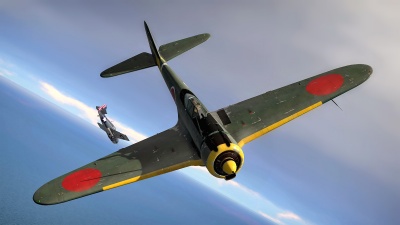
|
After the 10 improved prototypes were tested, the Army settled on what they saw was the optimum configuration and requested that the production aircraft be equipped with the Nakajima Ha-25 engine. The final design entered production as the Ki-43-Ia (Army Type 1 Fighter Model 1 Ko), with the first example completing production in April 1941. This model was soon replaced with the Ki-43-Ib (Army Type 1 Fighter Model 1 Otsu), which replaced one of the 7.7 mm machine guns with a 12.7 mm machine gun, which was also soon replaced by the Ki-43-Ic (Army Type 1 Fighter Model 1 Hei) which was equipped with two 12.7 mm machine gun. |
| Ki-43-II | |
|---|---|
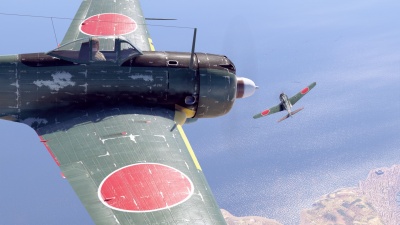
|
After some time in the field, the Ki-43 received a major upgrade based on feedback from pilots, which included replacing the Ha-25 engine with the more powerful Ha-115 engine, a two-stage supercharger, pilot armour, self-sealing fuel tanks and many more minor improvements. The first prototype of what was to become the Ki-43-II (Army Type 1 Fighter Model 2) was completed in February 1942. |
| Ki-43-II (USA) | |
|---|---|
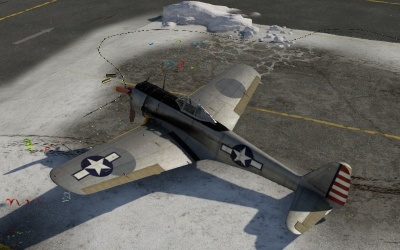
|
In late 1942, the Australian Army managed to capture an intact example of a Ki-43 while fighting the Japanese Army in Papua New Guinea. It was quickly shipped back to Australia for testing, where it ended up in the hands of the Technical Air Intelligence Unit, who managed to repair it using parts from downed airplanes. It was painted in US livery and was used to test its performance against Allied planes. After testing by the Technical Air Intelligence Unit, it was shipped to the United States for further evaluations. |
| Ki-43-III ko (China) | |
|---|---|
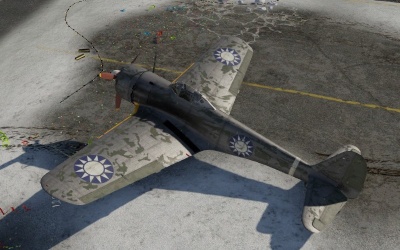
|
After the end of the war, some nations used the Ki-43, including the Indonesian People's Security Force who used them against the Dutch, and the French, who used them against Communist forces in Indochina. One such post-war user was the Nationalist Chinese Air Forces who operated captured Ki-43's in the 6th group. These saw use against the Communist Chinese forces in the Chinese Civil War, and 5 were eventually captured and used by the Chinese Communist Air Force until 1952. |
| Ki-43-III otsu | |
|---|---|
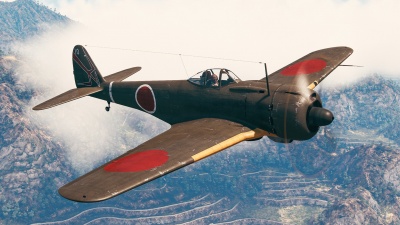
|
The last major modification of the Ki-43 was done in 1944, combining the minor modifications of the Model IIa and IIb with the more powerful Nakajima Ha-115-II engine. These minor modifications over the Ki-43-II included a reduced wing-span (improving the plane's low and medium speed performance), increased pilot armour, improved oil cooler, and modified carburettor intake. This new Ki-43-IIIa (Army Type 1 Fighter Model 3 Ko) entered production in October 1944, with approximately 1,000 completed before the war ended. |
| Nakajima Aircraft Company (中島飛行機株式会社 ) | |
|---|---|
| Fighters | Ki-27 otsu · Ki-27 otsu Tachiarai |
| Ki-43-I · Ki-43-II · Ki-43-III otsu | |
| Ki-44-I · Ki-44-I 34 · Ki-44-II otsu · Ki-44-II hei | |
| Ki-84 ko · Ki-84 otsu · Ki-84 hei | |
| Ki-87 | |
| Hydroplanes | A6M2-N* |
| Interceptors | J1N1 · J5N1 |
| Bombers | B5N2 |
| B6N1 Model 11 · B6N2 Model 12 · B6N2a Model 12Ko | |
| G5N1 · G8N1 | |
| Ki-49-I · Ki-49-IIa · Ki-49-IIb · Ki-49-IIb/L | |
| Recon | E8N2 |
| Jet Fighters | Kikka |
| Captured | ␗Ki-27 otsu · ▃Ki-43-II · ␗Ki-43-III ko · ␗Ki-44-II hei · ␗Ki-84 ko |
| *Refit of the Mitsubishi A6M2 mod. 11 | |
| See also | Fuji Heavy Industries (1957-2017) |
| Japan fighters | |
|---|---|
| Navy | |
| Carrier-based fighter | |
| A5M | A5M4 · Hagiri's A5M4 |
| A6M | A6M2 mod. 11 · A6M2 · A6M3 · A6M3 mod. 22 · A6M3 mod. 22Ko · A6M5 · A6M5 Ko · A6M5 otsu · A6M5 Hei · A6M6c |
| A7He | A7He1* |
| A7M | A7M1 (NK9H) · A7M2 |
| Land-based Fighter | |
| J2M | J2M2 · J2M3 · J2M4 Kai · J2M5 · J2M5 (30 mm) |
| J6K | J6K1 |
| J7W | J7W1 |
| N1K-J | N1K1-Ja · N1K2-J · N1K2-Ja |
| Fighter seaplane | |
| N1K | N1K1 |
| A6M-N | A6M2-N |
| Army | |
| Ki-10 | Ki-10-I · Ki-10-I C · Ki-10-II · Ki-10-II C |
| Ki-27 | Ki-27 otsu · Ki-27 otsu Tachiarai |
| Ki-43 | Ki-43-I · Ki-43-II · Ki-43-III otsu |
| Ki-44 | Ki-44-I · Ki-44-I 34 · Ki-44-II otsu · Ki-44-II hei |
| Ki-61 | Ki-61-I ko · Ki-61-I otsu · Ki-61-I hei · Tada's Ki-61-I hei · Ki-61-I tei · Ki-61-II Otsu Kai |
| Ki-84 | Ki-84 ko · Ki-84 otsu · Ki-84 hei |
| Ki-87 | Ki-87 |
| Ki-94 | Ki-94-II |
| Ki-100 | Ki-100 · Ki-100-II |
| Other countries | ▅F4U-1A · ▅P-51C-11-NT · ▅Bf 109 E-7 · ▅Fw 190 A-5 |
| *Imported designation of the He 112 (A6M was in development - A7M would take A7 designation after the cancelation of the A7He) | |



